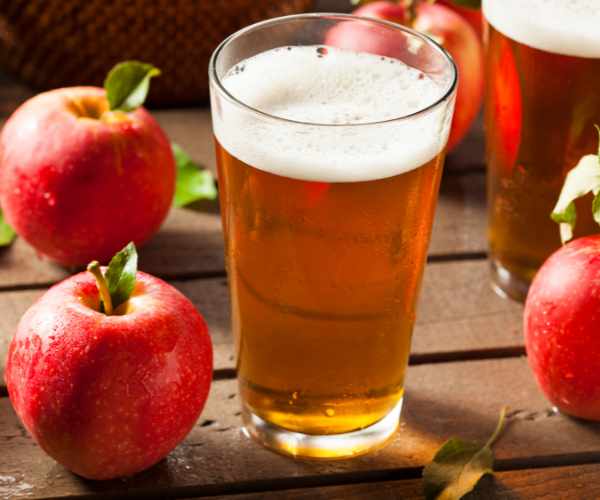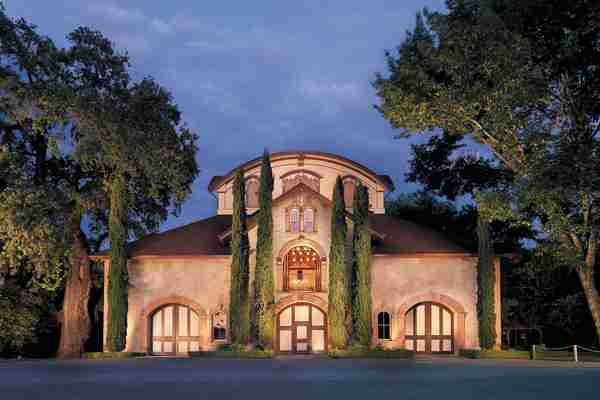
how To Make Hard Cider
Hard Cider is not “hard” to make. Just like wine, making your own hard cider at home is an entirely approachable hobby. With just a few pieces of brewing equipment, some of which you probably already have handy, and some simple equipment, you can turn out very drinkable cider at home.
Many home brewers start with unpasteurized apple cider available in pretty much any grocery store.
If you’re looking for a bit more detail grab a copy of The Big Book Of Cidermaking from Kirsten Shockey. This bestseller has led many a budding cider maker to the promise land of amazing homemade cider.
Of course, there are also plenty of great hard cider making kits available to help you get started on your own DIY hard cider.

Easy Hard Cider Recipe
Ingredients
Equipment
Method
- Sanitize everything.
- Heat ½ gallon of apple juice in a pot on medium heat, do not boil.
- Add the brown sugar and stir to dissolve, then remove the pot from the heat.
- In the empty one gallon brewing jug, add the cinnamon stick, cloves and raisins.
- Pour the warm cider from the pot into the one gallon brewing jug using the funnel. Allow the warm cider to steep with the spices for about 20 minutes.
- Top off the jug with the remaining ½ gallon of apple juice, leaving 2 inches of space at the top of the jug. There will be some leftover juice.
- Cap the jug and shake to combine everything.
- Check temperature regularly. Add ½ package of yeast to the jug when the juice has cooled to 90°F, (it doesn’t have to be exact). Store the opened package with the remaining yeast in the refrigerator for later use.
- Cap the jug again and shake, shake, shake for about a minute or two to aerate the yeast.
- Attach the airlock to the rubber stopper if you haven’t already, fill it with water to the fill line, then place it firmly on the top of the jug.
- Put the jug in a cool (not cold) place out of direct sunlight to ferment. Maybe a pantry or laundry room. After several hours, or overnight, you will start to see bubbles forming in the jug and airlock.
- Allow the cider to ferment for 3-4 weeks, until the bubbling in the jug and airlock has stopped.
- Bottle your cider!
- Sanitize and dry everything.
- Attach one end of the tubing to the auto siphon and the other end to the bottling wand.
- Put the jug of cider onto the counter and one person will put the auto siphon into the jug without touching the sediment on the bottom.
- Put the bottles on a towel on the floor below the gallon jug. Use gravity.
- Put the bottling wand into one of the bottles. Person 1 will pump the siphon two or three times to get the cider flowing.
- Pull the bottling wand up when the cider gets about an inch from the top of the bottle. The flow will stop immediately.
- Repeat this process for each bottle.
A Guide To Hard Cider
Once upon a time, Americans considered cider the obligatory (non-alcoholic) beverage of the kids table at Thanksgiving. It never occurred to us that cider could be a complex, food-friendly, adult beverage. Happily, though, over the last few years, there has been a hard cider renaissance in this country (English readers, consider this a recognition of our serious delay in rediscovering this lovely drink).
As of today, hard cider represents just 1% of the entire alcoholic beverage market, but its growing fast with retail sales reaching $222 million USD in 2020 and expected to annually by 10%. (stats courtesy of The Food Institute.
So in our best Jerry Seinfield voice we ask “What’s the deal with hard cider?”
What Kind Of Apples Are Used For Hard Cider
If you’re using apples to make your cider, there are over 30 different varieties of apples used to make cider in Virginia alone, and none of them make for good eating. Cider apples are bitter, and some are downright ugly — if picked one and took a bite, you probably wouldn’t do it again.
Cider apples are sometimes called spitters — because they are too bitter to eat. Cider apples have more acid and tannin (just like wine grapes) than eating apples, which is what gives finished cider its structure. Diane Flynt of Foggy Ridge Cider says, “cider is a 3-legged stool with a balance of acid, tannin and fruit.”
Cider apples can be classified into 4 types:
- Sweets = low acid, low tannin
- Sharps = high acid, low tannin
- Bittersweets = low acid, high tannin
- Bittersharps = high acid, high tannin
History Of Hard Cider In America

The history of hard cider in America is a long and storied one. From its early roots as a drink enjoyed by the Founding Fathers to its current resurgence as a popular adult beverage, hard cider has always been a part of American culture.
One of the earliest references to hard cider in America comes from none other than Thomas Jefferson. Jefferson made his own cider at Monticello, and served cider as his “table drink” with most meals. Jefferson’s close friend, John Adams, reportedly drank a tankard (think lidded German beer stein) of cider to start each morning. Benjamin Franklin was a huge cider fan as well, once saying, “It’s indeed bad to eat apples, it’s better to turn them all into cider.” These guys probably never had to go to the doctor.
As with so many stories of alcohol in America Prohibition plays a big part in the history of hard cider.
Prohibition was a pain in the arse. Prohibitionists burned cider apple orchards (many containing heirloom varieties dating back to colonial times) to the ground and replanted them with sweet, eating apples. After Prohibition was repealed, it took years to convert the orchards back to cider apples, a conversion that’s ongoing even today. With cider enjoying a renaissance in America, the demand for cider is increasing, but orchards can’t keep up with demand.
How Is Hard Cider Made
Cider is made from fermented apples or apple juice. And, like wine, great cider starts with great fruit. It takes 36 apples to make one gallon of cider. But unlike wine, apples have to be ground before they can be pressed — the ground apple pulp is called pomace. The best ciders are made from blending apples from different orchards. Huh. That sounds familiar.
Incidentally, America is the only country (that we know of) that calls alcoholic cider hard cider. In England it’s just cider. Stephen Schuurman of Winchester Cider Works says, “Our aim is to drop the word hard through education.” Stephen is English, btw.
Alongside apples, cider (along with almost every other crop really) owes a huge head nod to the humble but vital bee. Bees have a very important job in cider making — without pollination, there’s no fruit. And without fruit, there’s no cider. So, all hail bees! In fact, Blue Bee Cider is named after the blue orchard bee. Courtney Mailey told us, “a honey bee sets 60 fruit in a day. A blue bee sets 2000. They’re more productive.” And busy!
Types Of Hard Cider
American cider makers are experimenting, and styles of cider can and do vary wildly. It helps to get your head around some basic styles to understand the huge variety of ciders on the market today.
Dry Cider – less than 0.5% residual sugar. Tannic and acidic, often aged in barrels.
Off-Dry Cider – 1-2% residual sugar.
Semi-Dry and Semi-Sweet Ciders – anything above 2% sugar.
Farmhouse Cider – often made with native yeasts and a higher ABV — up to 12%.
The notion of sweetness in cider can be confusing. How can you tell from looking at a bottle of cider if it’s dry, off-dry or semi-dry? We asked Anne Shelton of Albemarle Cider Works if the cider world had a dryness scale, similar to the Riesling IRF scale. According to Ann, “Levels of dryness in the cider community vary. We have no confirmed scale yet.” We’re holding out hope that a dryness scale will be settled on in the future.
How To Serve Hard Cider
As with any other alcoholic drink, hard cider can be served in a variety of ways.
Some people like to drink hard cider cold, just like they would drink beer or soda. Others prefer to serve it at room temperature, or slightly warmed. And still others enjoy a nice, warm hard cider fireside.
Hard cider can also be used in cocktails. For example, you could mix hard cider with bourbon to make a Kentucky Buck, or with ginger beer to make a Moscow Mule. There are endless possibilities!










